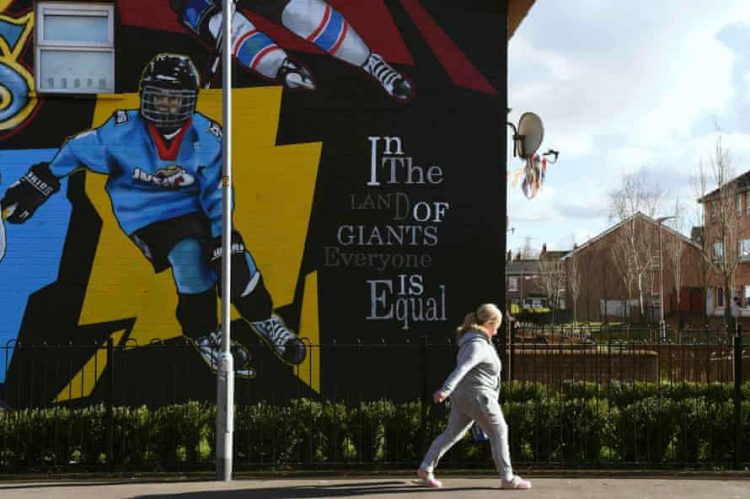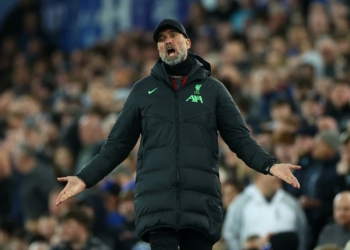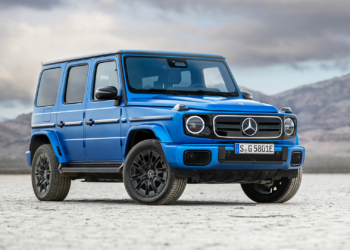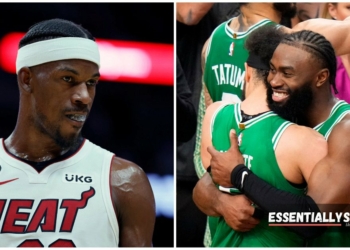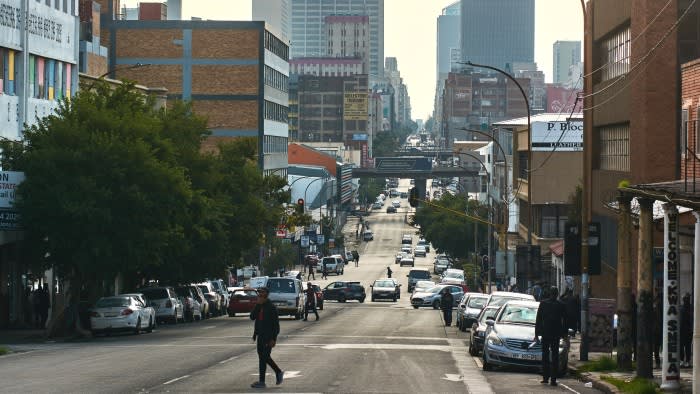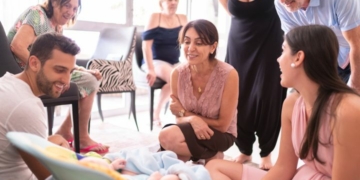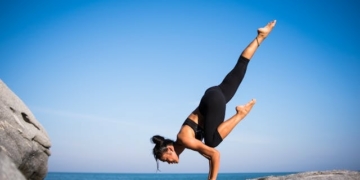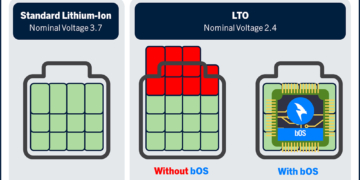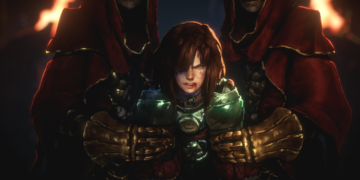The Belfast Giants celebrated their 22nd birthday recently and the party shows no sign of stopping. The Giants won the Challenge Cup last month, beating Cardiff Devils in a sold-out final in front of 7,300 home fans, and they are top of the UK-wide Elite Ice Hockey League with a few games to play. Winning the double would be a huge achievement, but the Giants have been exceeding expectations for decades.
Belfast was a very different place when the Giants played their first match in December 2000. The Good Friday agreement was just two years old and the city had been scarred by a conflict that remained raw. There was peace on the streets but it was fragile, and the sporting landscape was as entrenched and traditional as ever.
Sports fans in Belfast lived on a limited diet of rugby, football and Gaelic games. The Ulster rugby team had just won the European Cup but they played in a rickety, windswept mausoleum of a ground in east Belfast that was mostly favoured by Protestant fans. The Antrim hurling team played in the heart of nationalist West Belfast at Casement Park, but their glory days were long gone. And the various Irish League sides across the city were tied to political tribes. Sectarian chanting was common and made attending a game a rotten experience for anyone who yearned for a brighter expression of local pride.
The city needed something new, but the foundations for a professional ice hockey in Belfast were flimsy at best. There was (and remains) only one ice rink in Ireland and the sport was barely known, never mind understood. Would thousands of fans pay to watch North American athletes play an alien sport in a new venue? The Millennium Commission had stumped up £45m to build a gleaming arena in the shadow of the city’s shipyard, but the thought that an ice hockey team would bring in thousands of spectators still felt far-fetched. Those shipyards were famous for building the Titanic, after all, and that had not lasted for long.
There was a method behind the apparent madness, though. Ice hockey was so new and so bizarre that it carried none of the traditional barriers that weighed down other sports. The team would represent the whole of Belfast. Giants fans are quick to tell you “in the land of the Giants, everyone is equal” and, in a sport known for its brutal hits, it was quickly established as one of the most family-friendly places in the city.

Robert Fitzpatrick, who grew up in Northern Ireland in the 1970s and is now the CEO of the company that owns the Giants, says inclusivity was vital to their vision. “Right from the start, the Giants was a place where everyone was welcome. I mean everyone: Protestants, Catholics, the LGTB community, it doesn’t matter. Everyone is equal. Our colour is teal and that plays a strong part in our identity. There have never been any football jerseys allowed in the arena. If we see a young kid in a football shirt, we just give them a Giants T-shirt and they put it on. We are now seeing generations of families in this city who are fans.”
The Canadians who signed for the Giants played a brand of ice hockey that thrilled the crowd. The rules still had to be explained regularly in the programme notes, by the arena announcer or even by the team’s mascot, Finn McCool, the mythical Irish giant. But the fanbase grew every year and so did their knowledge of the game. The Giants now play to bigger crowds than any of Northern Ireland’s football clubs.
Paddy Smyth was studying at Queen’s University in Belfast when he attended the team’s first game against the Ayr Scottish Eagles in 2000. “I had grown up in west Belfast and had family from Detroit. I remember one of my relatives visiting in the 1990s and talking about the Red Wings. I kept up with the sport vaguely and then saw the first Giants game advertised for six quid. I couldn’t say no. I went and it stuck with me.

“You go to the games and feel this immense pride in your city. I love chanting: ‘Come on Belfast.’ That’s who I’m supporting. I grew up with Gaelic football and football, but there wasn’t the same connection. Going to Giants games and making friends with people from all sorts of backgrounds stuck with me. We’re all bound by supporting the Giants and that’s exactly what sport should be.”
Paddy made an unlikely friend through the sport. “My friend Davy and I are really opposites. I’m a Catholic from a Republican background; he’s a Protestant and an Orangeman. Through the Giants we had a common interest and that’s all that has ever mattered.”
Davy says he started going to games with his wife. “I used to watch Glentoran play football in east Belfast, but she wanted to go somewhere that was under cover, safe, and had food and clean toilets. In Belfast, if you grow up in a certain area, it can be hard to know someone from outside your background. Even now, I’d struggle to tell you Catholic friends I have from Belfast outside of hockey. With Paddy, we shared this love of the Giants, got a podcast going together, and it’s a friendship I continue to value. We’re diametrically opposed politically but we agree to disagree. You will find loyalists and republicans sitting together at games. It doesn’t matter and never has.”

Davy is convinced that the strategists behind the Giants missed one important selling point for the club. “One of the greatest recruiting tools the Giants have is the women of Belfast. There are so many former players who have stayed in Northern Ireland after they have finished. Around 20 have never left.”
One of them is the Giants’ coach, Adam Keefe, who moved to Belfast from Ontario 11 years ago as a player, married a local and never left. “I was totally ignorant about the history of Belfast,” he says. “I remember a newspaper asked me for a quote and I said something like: ‘I can’t wait to bring the fighting Irish back to Ireland.’ It never ran in the newspaper and I didn’t understand why. The great thing about the Giants is that they really spend time educating you on the city and your responsibility playing here. You’re not playing for a normal team – you have a responsibility to represent Belfast as we know what the Giants mean to people here.

“When I signed up, a friend asked me if Belfast was safe to visit. Now our players who come over from Canada and the States absolutely love it. They couldn’t be treated better. When I first arrived, I was surprised. I mean hockey in Ireland? Yet everyone who comes absolutely loves it. You don’t even need to sell the Belfast Giants. Players just want to come. I found that shortly after I arrived. I wanted to stay here my whole career and luckily I met my wife.”
The team’s general manager, Steve Thornton, is another Canadian who arrived as a player and has not been able to leave. He went back to Canada to start a corporate career when he retired, but his family missed Belfast so they returned. “I remember coming here 20 years ago and the city’s name was synonymous with what people in Canada had heard about on the news. I loved it right from the start. It was almost like the people were overcompensating in friendliness. They were so keen to make sure you enjoyed their city. Hockey is mainstream in Belfast now. We want Northern Irish people to have a team that they can be proud of and we think that’s definitely been achieved.”
In the programme notes for the Giants’ first home game in 2000, the Belfast Telegraph journalist Stewart McKinlay wrote: “It will be a proud day when a Northern Irish player steps out as a Belfast Giant.” That ambition has become a reality, with nine players from Northern Ireland lacing up their skates to play for the Giants.
Goaltender Andrew Dickson grew up in Ballymoney, an hour’s drive north of Belfast. “The first time I heard about ice hockey was from a friend who had come back from a cross-community trip to Philadelphia. He had been to a Flyers game and couldn’t stop talking about how amazing it was. We bought the video game, couldn’t stop playing that, and then at 17, we started playing inline hockey – initially in the local Tesco car park but we eventually set up a league in the leisure centre. We kept getting hammered but I was in nets, so I was getting lots of practice and eventually was spotted to play the Junior Giants.”

Dickson trained in Belfast through the week – driving an hour to start at 10.15pm and making it back at 1.30am – while studying in a technical college. There was no junior league in Northern Ireland, so he took the ferry to Scotland every weekend to compete. “There was a lot of hard work, and I suppose an element of some talent, and after three years, I was lucky enough to get to play for the Giants. I had no family background in ice hockey. It’s funny, my dad didn’t follow it all. In fact, I remember telling him that I would be playing my first game for the Giants and he said he’d be going to see Rangers instead. Now he absolutely loves it. He’s at every game and even brings the neighbours down.
“I just loved playing this sport from the start, and always had that fear that eventually I’d get found out, but I’m still here. My real hope is that I’ve inspired a kid not just from Belfast, but from somewhere else in the country to get out and dream that they can play for the Giants.”
The Giants are fighting to clinch the double, but their plans are bigger than winning silverware. The club is lobbying to have a second ice rink built in Northern Ireland so more children can play the sport. The team has inspired all sides of the community in Belfast. Now they want their young fans to play the game. The odds are not in their favour, but they have a habit of overcoming them.
Jonathan Drennan is on Twitter and you can read his articles here.
